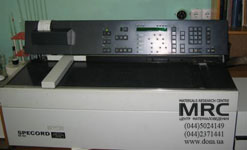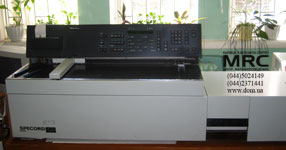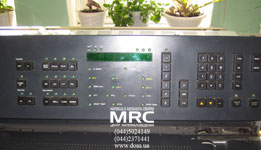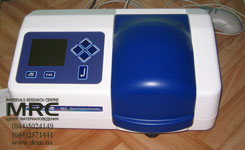Methods of analyses
X-Ray crystallography
X-Ray crystallography is a method of defining the arrangement of atoms within a crystal, in which an X-ray strikes a crystal and causes the beam of light to spread into many specific directions. Diffraction pattern depends on the wavelength of X-Rays used and the object structure. To study an atomic structure one applies an atom wavelength radiating.
By means of X-Ray crystallography one studies metals, alloys, minerals, inorganic and organic compounds, polymers, amorphous materials, liquids and gases, protein molecules, nucleic acids etc. X-Ray crystallography is the main method of crystals structure defining.
It provides with the most extensive information while studying crystals. It’s conditional on the crystals structure exact periodicity and represents itself a diffraction pattern for X-rays created naturally. However it gives significant data and while studying solids with less ordered structure, like liquids, amorphous solids, liquid crystals, polymers and others. Based on lots of already identified atomic structures an inverse task can be done: by X-Ray pattern of polycrystalline material, for instance alloy steel, alloy, ore, moonrock, a crystalline composition of the material can be defined, i.e. carrying out of phase analysis.
X-Ray crystallography enables impartial determination of crystalline materials, including compounds like vitamins, antibiotics, coordination compounds etc. The detailed structural study of the crystal often enables to do chemical tasks, for instance defining or specifying of a chemical formula, bond type, molecular weight with a known density or a density with a known molecular weight, symmetry and configuration of molecules and molecular ions.
X-Ray crystallography is applied successfully in studying of polymers crystalline state. It also gives important data while studying of the amorphous solids and liquids. X-Ray patterns of such solids contain several diffused rings, intensity of which is going on rapid decreasing by zooming. By width, shape and intensity of these rings one can conclude on peculiarities of the short-range order in a certain liquid or amorphous structure.
 |
 |
| X-Ray diffractometers "DRON" | |
X-Ray fluorescence analysis (XFA)
XFA is one of the modern spectroscopic methods to study materials in order to obtain their elemental composition, i.e. their elemental analysis. XFA method is based on recovery and spectrum, obtained by X-ray effecting the studied material further analyzing. Being radiated atom is transiting into activated matter, accompanied by transition of the electrons on higher quant levels. Atom is activated near 1 microseconds, after that its returns to a quiet state (regular state). Electrons from outer shells either fill in formed vacant spaces and energy surplus is emitted as photon or energy is transmitted to another electron from outer shells (Auger electron). Each atom emits a photoelectron with the energy of a certain value, e.g. iron being X-rayed, emits photons К?= 6,4 keV. Then by the energy and quantity of quants one can discuss the material structure.
In X-Ray fluorescence spectrometry one can compare samples not only by spectrum elements characteristics and by intensity of the background (bremsstrahlung) radiating in details but also by the lines shape of Compton scattering. It does make sense when chemical composition of the two samples is equal according to the quantitative analysis results, but samples are differing by other properties, like granularity, crystals size, surface roughness, porosity, moisture, crystallized water presence, quality of polishing, width of spatter etc. Identification is performed by spectra detailed comparison. There is no need to know the sampling chemical composition. Any distinction of the compared spectra confirms distinction of the sample from reference.
 |
| X-Ray fluorescence microanalyzer VRA-30 (Germany) Range to 14 uranic elements |
The given type of analysis is done when need to identify the two samples (one of which is a reference) composition and some physical properties. This analysis is of significance when searching any distinctive features of the two samples composition. Field of application: defining of heavy metals in soil, sediments, water, aerosols, qualitative and quantitative analysis of soil, minerals, rocks, control of the raw material quality, production and engineering out-put process, lead paints analyzing, measuring of the valuable materials concentration, determining of oil and fuel contamination, analyzing of microelements in soil and agricultural products, determining of toxic metals in foodstuffs, elemental analysis, archeological finds age determination, study of paintings, sculptures, analysis and expert examination.
Usually, preparation of samples for any analysis does not make any complexity. To do a high-reliability quantitative analysis the sample must be homogeneous and representative with mass and size not less than it’s required by the analysis procedure. Metals are finished; powders are reduced to a fraction with a set size and pressed into pills. Rocks are alloyed to a glass-like state (to prevent inaccuracies because of the sample heterogeneity). Liquids and bulks are put into special-purpose caps.
Spectrum analysis
Spectrum analysis is a physical method of qualitative and quantitative defining of atom and molecular material composition, based on its spectra study. SA physical base is spectroscopy of atoms and molecules, it’s classified by the analysis objectives and types of spectra (see Optical spectrum). Atom SA (ASА) defines elemental composition of the sample on atom (ion) spectra of emission and absorption. Molecular SA (МSА) is the materials molecular composition by the molecular spectra of absorption, luminescence and combinational light scattering. Emission spectroscopy is done by spectra emission of atoms, ions and molecules activated by various sources of electromagnetic radiation raging from?-radiation up to microwave one. Absorption SA is done by spectra of electromagnetic radiating absorption by the objects being analyzed (atoms, molecules, ions of the material being in different aggregate of states). Atomic Absorption Spectroscopy (АAS) Emission ААS is composed of the following main processes:
- representative sampling, reflecting average composition of the analyzed material or local distribution of the elements being defined in the material;
- sample injection into emission source where solid and liquid samplings evaporation, compounds dissociation, atoms and ions activation take place
- their luminescence conversion into spectrum and its record (or visual examination) by means of spectrum analyzer;
- obtained spectra identification by means of tables and spectral atlases.
By this stage qualitative ААS is coming to an end. Sensitive (“the latest”) lines remaining in the spectrum under minimum concentration of the defined element are the most effective. Spectrograms are studied under the measuring microscopes, comparators and spectroprojectors. To analyze in due way, availability or lack of analytic lines in the elements being defined is enough. By the brightness of lines at visual view one can give a raw count of the elements in samplings composition.
Quantitative AАS is done by comparing two spectrum lines intensities in the sampling spectrum, one of which is the defined element’s constituent and the other one (comparison line) is part of the sampling basic element, concentration of which is known or specially injected into the element in a known concentration(«internal standard»).
In AFS atomic sampling couples are radiated with the resonance radiating source. After that one records the defined element fluorescence. For some elements (Zn, Cd, Hg etc.) relative limits of their detection are quite small (10-5—10-6 %).
 |
| Computer-aided atomic absorption spectrum analyzer AAS-3 (Germany) with flame automation |
AAS can measure isotopic composition. Isotopic composition of some elements like Н, Не, U can be measured via usual spectrum devices by means of the luminous sources, which give thin spectrum lines (hollow cathode, electrodeless rf and microwave lamps). To do an isotopic spectrum analysis of most elements one need tools with high resolving power (e.g. Fabry-Perrot interferometer). Isotopic spectrum analysis can also be done by electron vibration spectrum of molecules, measuring isotopic shifts of the lines reaching considerable value in loads of cases.
ASA is of great importance in atomic engineering, producing of highly pure materials, superconductors etc. More than ¾ of all analysis in the steel industry are done by the ASA methods. While melting in open-heart and converter industry one performs compulsory control (within 2-3 minutes) via quantometers. In geology and geological exploration one does about 8 mln. of the analysis per year to assess deposits. ASA is applied to protect environment and analyze soil. It’s also used in medicine, geology of the sea floor, study of the atmosphere upper layers composition, isotopes separation, aging and defining of geological and archeological objects composition etc.
Infrared spectroscopy
Infrared spectroscopy includes obtaining, study and spectra of emission application, absorption and reflecting application in the spectrum infrared (0,76-1000 mkm) area. IRS mainly deals with molecular spectra study as IR area contains majority of vibration and rotary spectra of molecules. IR absorption spectra arising while IR radiation is travelling through the material is the most explored.
IR absorption spectrum is probably a unique physical substance of its kind. There can’t be two compounds, but for optical isomers with differing structures and the same IR spectra. In some cases like polymers with similar molecular mass, differences can be insignificant but they occur. In most cases IR spectrum is the “fingerprint” of a molecule, which can be easily distinguished from other molecules spectra.
Moreover, absorption typical for separate groups of atoms, its intensity is in direct proportion to their concentration. After simple estimations measuring of the absorption intensity gives quantity of the given component in the sample.
IR spectroscopy is applied in the semi-conductor materials, polymers, biological objects and living cells. In dairy industry IR spectroscopy is applied to define mass concentration of fat, protein, lactose, dry matters, freezing point etc.
Usually liquid matter is removed as a thin film between NaCl and KBr salt caps. Solid is mostly removed as paste in Vaseline oil. Solutions are removed in collapsible ditches.
Visible and Near-Ultraviolet Absorption Spectrum
On the basis of Absorption spectroscopy or property of solutions to absorb visible light and electromagnetic radiation in a close to it ultraviolet range, a principle of the most widespread photometric instruments for medical laboratory studies – spectrophotometers and photocolorimeters (visible light) is based.
Each material absorbs the radiation with power able to change a molecule of the material. To say it differently, the material absorbs radiation only of a certain wavelength and light of another wavelength passes through solution. That is why solution color in a visible area perceivable with a human’s eye, is defined by the radiation wavelength. That is, color observable by a researcher is an additional one in relation to radiation absorption color. The basis of Absorption spectroscopy is Beer–Lambert–Bouguer law, often referred to us as Beer’s law. It’s based on two laws:
1. Relative amount of luminous flux power, absorbed by the environment does not depend on intensity of radiation. Each absorptive layer of equal width absorbs equal portion of the monochromatic luminous flux travelling through these layers.
2. Luminous energy monochromatic flux absorption is directly proportional to number of molecules of the absorbed material
Thermal analysis
Thermal analysis is a branch of materials science where the properties of materials are studied as they change with temperature. Theoretically TA is applicable to lots of systems as enthalpy ?H is changing in a result of most physical and chemical processes and chemical reactions.
In TA one can fixate the heating curves (cooling curves) of the studied sample, i.e. temperature changes of the latest in time. In case of any phase transformation in the material (or the material mix) there arises an area or fractures on the curve.
Differential thermal analysis (DTA) is more sensitive. In DTA, the material under study and an inert reference are made to undergo identical thermal cycles, while recording any temperature difference between sample and reference (more often Аl2О3) not suffering any transformation in the given interval. This differential temperature is then plotted against time, or against temperature. Changes in the sample, either exothermic or endothermic, can be detected relative to the inert reference.
Thus, a DTA curve provides data on the transformations that have occurred, such as glass transitions, crystallization, melting and sublimation as well as chemical processes (dissociation, decomposition, dehydration, oxidation-reduction etc.). Most of transitions are accompanied by endothermic effects; only some processes of oxidation-reduction and structural transition are exothermal.
Mathematic correlations between the area of peak on the DTA curve, the instrument and sample parameters enable to record heat of transition, energy of phase transfer activation, some kinetic constants, to do semi-quantitative analysis of (if DH of proper reactions is known). By means of DTA one studies decomposition of acid metals, various metal-organic compounds, oxide high-temperature superconductors. With the help of this method one defined temperature area of the conversion СО in СО2 (while exhaust gases from vehicles afterburning, emissions from heat electropower stations etc.). DTA is applied to chart phase diagrams of systems with different amount of components (physical and chemical analysis), for samples qualitative assessment, e.g. while comparing various lots of raw materials.
Derivatography is a complex method in thermal analysis which explores chemical and physical and chemical processes taking place in the material in conditions of the temperature programmed changing.
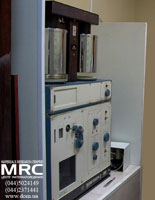 |
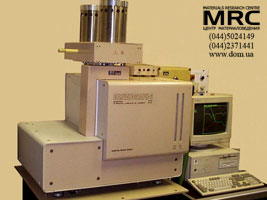 |
| Derivatographs 1000 D and S "Mom" (Hungery) Maximum temperature 1500oC | |
This method is based on combination of differential thermal analysis (DTA) with one or a few physical or physical and chemical methods, e.g. thermogravimetry, thermomechanical analysis (dilatometry), mass-spectrometry and emanation thermal analysis. In all case along with changes in the material, occurring with thermal effect, one records the sample mass changing (liquid or solid one). This enables to define character of processes in the material which can not be done just according to DTA data or other thermal methods. Indicator of phase transition, in particular, is a thermal effect not accompanied by changes of the sample mass. Derivatograph is a device which records simultaneously thermal and thermogravimetric changes. In a derivatograph, operating by means of DTA and thermogravimetry combination, the holder with a studied material is put on thermocouple, freely suspended on a scale-beam. Such a construction enables to record 4 relations: temperature differences of the sample and reference with no conversions from time t (DTA curve), Dm mass changing from the temperature (thermogravimetric curve), speed of the mass changing, i.e. derivative dm/dt, from the temperature (differential thermogravimetric curve) and temperature from time. It is a success to determine the material conversion succession and define quantity and composition of intermediate products.
Chemical analysis methods
Gravimetric analysis describes a set of methods in analytical chemistry for the quantitative determination of an analyte based on the mass of a solid.
In most cases, the analyte must first be converted to a solid by precipitation with an appropriate reagent. The precipitate can then be collected by filtration, washed, dried to remove traces of moisture from the solution, and weighed. The amount of analyte in the original sample can then be calculated from the mass of the precipitate and its chemical composition. Gravimetric analysis is one of the most universal method. It’s applied for defining of almost any element.
Firstly the two components are isolated, transformed into gravimetric state and the weighted. Then one of the compounds or both are converted into another gravimetric state and then weighted one more time. Each components composition is measured by means of simple calculations.
The most essential quality of the gravimetric measuring is high accuracy of the analysis. Usual inaccuracy of the gravity measuring is 0,1—0,2%. While analyzing samples of a complex composition, inaccuracy is increasing up to several percents owing to the methods of separation and isolation of the analyzed component imperfection.
Advantages of the gravimetric measuring are also lack of any standardization or calibration by typical samples, required for almost every analytical method.
To perform gravimetric measuring, one needs molar mass and stoichiometric correlations.
Titration analysis also known as titrimetry is one of the qualitative analysis methods. Titrimetry is gradual adding of a titrant or titrator to an analyzed solution to measure the equivalence point. Titration analysis is based on the titrant volume measuring of a known concentration, consumed by reaction of interaction with a certain material. The basis of the method is measuring of volumes of the two interreacting materials. Quantitative measuring by means of titration analysis is performed quickly enough. This enables to perform several parallel measurings and obtain more accurate arithmetical mean. The basis for all titration analysis calculations is law of equivalent proportions. According to the character of chemical reaction, being the basis for the material defining, methods of titration analysis are divided into the following groups: neutralization method, oxidation-reduction method and chelation method.
| Methods of the materials and constructions mechanical study and testing |


